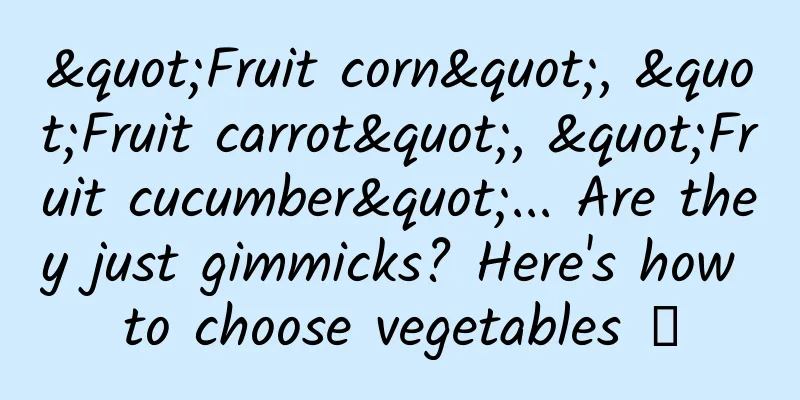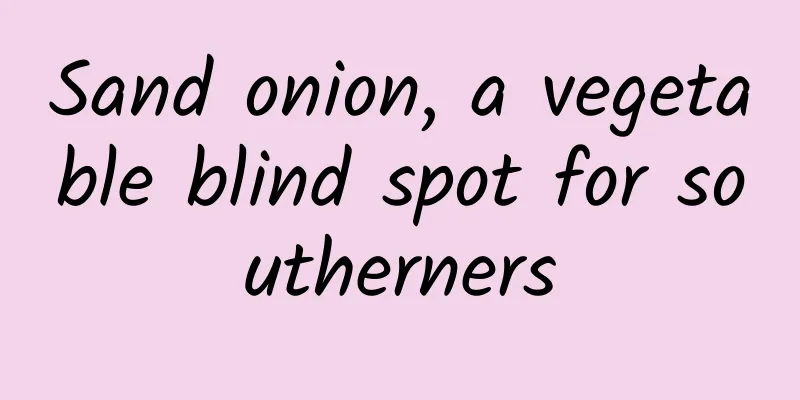"Fruit corn", "Fruit carrot", "Fruit cucumber"... Are they just gimmicks? Here's how to choose vegetables →

|
Have you seen many vegetables labeled as fruits in the market, such as "fruit corn", "fruit carrot", "fruit cucumber", "fruit tomato", etc.? Do you think these vegetables are high-end ingredients and plan to buy them to try, or do you have doubts about them and think they are mutant varieties and bad for your health? From a health perspective, are fruit-type vegetables good or not? 01 Is vegetable and fruitization a gimmick? According to the "Classification and Code of Fresh Vegetables" (SB/T10029-2012) issued by the Ministry of Commerce, vegetables refer to herbaceous plants that can be used as side dishes, as well as a few woody plants and fungi that can be used as side dishes. The "Chinese Food Composition Table" (6th edition, Volume 1) combines the classification of vegetables with the actual application of dietary nutrition surveys, and divides vegetables into 8 subcategories: root vegetables, fresh beans, eggplants/melons and vegetables, onions and garlic, tender stems/leaves/cauliflowers, aquatic vegetables, potatoes and taro, and wild vegetables. At the same time, the food composition table divides fruits into six subcategories based on the morphology and physiological characteristics of the fruits, including pome fruits, stone fruits, berries, citrus fruits, tropical/subtropical fruits, and melons. Therefore, from the perspective of plant classification and food classification, vegetables and fruits belong to two different food categories. Are fruit-type vegetables just a gimmick promoted by businesses? From a scientific perspective, fruit-type vegetables have a long history of research. For example, the breeding research of fruit-type corn began in the early 1950s and early 1960s. Professors Li Jingxiong and Zheng Changgeng of the former Beijing Agricultural University (now China Agricultural University) introduced a batch of sweet corn from abroad and began to conduct sweet corn breeding research. In 1968, they bred the first ordinary sweet corn named "Beijing White Sugar". Later, through the continuous research and development of scientists, by the 21st century, the quantity and quality of sweet corn varieties bred in my country had made great progress, especially the research on super sweet corn and enhanced sweet corn had achieved remarkable results. Copyright images in the gallery. Reprinting and using them may lead to copyright disputes. 02 How nutritious are fruit and vegetables? Vegetables are the main source of vitamins and minerals. They also contain more cellulose, pectin and organic acids, which can stimulate gastrointestinal motility and the secretion of digestive juices, thus promoting people's appetite and helping digestion. Fresh fruits are also an important food source of vitamins and minerals. They have a high water content and a relatively low nutrient content. However, most fruits are eaten raw, which can provide us with more vitamin C. Most vegetables will lose a lot of vitamin C during the heating process, which is one of the reasons why vegetables and fruits cannot be replaced by each other. Compared with edible vegetables, fruit vegetables are sweeter and more suitable for fresh consumption. The total sugar content of "fruit corn" is 33.6%, protein is 10.6%, and fat is 9.1%. Every 100 grams of edible part of ordinary fresh corn contains 22.8 grams of carbohydrates, 4.0 grams of protein, and 1.2 grams of fat. The content of glucose, sucrose, fructose and other sugars in the kernels of "fruit corn" is 2 to 8 times that of ordinary corn. The monosaccharide content of "fruit corn" is 5 times that of glutinous corn. The sugar content of glutinous corn is 0.9%, while the sugar content of fruit corn reaches 4.5%. **Fruit vegetables also differ from vegetable vegetables in appearance. **For example, compared with ordinary vegetable cucumbers, "fruit cucumbers" are thornless and petite, and are "good-looking, easy to wash, and delicious". Compared with vegetable tomatoes, "fruit tomatoes" are smaller in size, thin-skinned, tender, and generally weigh 15 to 120 grams. Vegetable tomatoes are harder and suitable for transportation, and the weight of a single fruit is generally 200 to 300 grams. Compared with ordinary carrots, "fruit carrots" have smooth skin, bright colors, crisp and sweet flesh, and are more suitable for eating raw. Copyright images in the gallery. Reprinting and using them may lead to copyright disputes. 03 Are fruit and vegetables harmful to the human body? Fruit-type vegetables are the scientific research results of generations of scientists through breeding and are suitable for human consumption. So far, no research has been found to show that fruit-type vegetables are harmful to health. The research and development of fruit-type vegetables has, to a certain extent, made up for some of the shortcomings of edible vegetables, just like hybrid rice is more productive and artificially cultivated papaya is suitable for consumption. 04 Daily vegetable shopping suggestions Should I choose vegetable-type vegetables or fruit-type vegetables? You don't have to worry about this question. Vegetable-type vegetables are a must and are an important ingredient that cannot be missing from three meals a day. **Fruit-type vegetables are generally more expensive, so you can make a reasonable choice based on your own situation. **Just ensure that you consume 200~350 grams of fresh fruit every day. Freshness and seasonality are also prerequisites. Vegetables and fruits have different nutritional values and cannot replace each other. The advent of fruit-type vegetables does not mean that vegetables can replace fruits, but only adds another food choice for us. Food diversification is our way to obtain more nutrients, and no single food can meet the body's needs for all nutrients. According to the "Dietary Guidelines for Chinese Residents (2022 Edition)", healthy people over 2 years old should consume more than 300 grams of fresh vegetables per day, of which dark vegetables account for more than half, so that there are vegetables at every meal. When choosing vegetables for daily life, we should pay attention to "freshness", "color" and "quality". "Freshness" means freshness. Choose fresh and seasonal vegetables. Fresh vegetables are full of water, taste good and have sufficient nutrients. "Color" refers to color. Make sure to eat half of the dark-colored vegetables every day. Dark-colored vegetables such as green, red, orange, and purple contain more carotene and phytochemicals. Fresh vegetables of different colors are also a good way to achieve food diversity. "Quality" refers to variety. Make sure to eat 3 to 5 kinds of vegetables every day. Root vegetables, root vegetables, fresh beans, eggplants/melons and vegetables, onions and garlic, tender stems/leaves/cauliflowers, aquatic vegetables, and potatoes are all good choices for dietary ingredients. **Make a good food purchase plan based on the number of people eating at home. Whether it is vegetable or fruit, fresh and seasonal vegetables are good ingredients. **Eating enough variety and weight, and matching different ingredients well are the guarantee of a healthy life. Source: Healthy China The cover image and the images in this article are from the copyright library Reprinting may lead to copyright disputes |
<<: How important is the liver to us? Let's take a look at the fate of a liver
Recommend
Uber's self-driving truck completes first delivery
Foreign media reported that in the early morning ...
Analysis of Luckin Coffee’s private domain operations!
The reason why I want to dismantle Luckin is beca...
Does poor sleep lead to a bad mood, or does a bad mood lead to poor sleep? Decoding the relationship between sleep and mood
Leviathan Press: There is a classic scene in the ...
This seasonal rose-colored sea of flowers is actually called Pig
I still remember that it was the end of April, th...
Will the smallest robot be smaller than an ant?
In Journey to the West, in order to force Princes...
How should operations be performed in the three stages of APP development?
The bell of 2017 has rung. As I am about to enter...
Today is the end of the dog days. All four seasons are pleasant, but the best is the new autumn.
There is no heat through the east window at night...
Yuanfudao product analysis!
With the continuous development of the Internet, ...
Testin, the world's largest application cloud testing platform, received US$54.9 million in financing
On July 18, 2015, at the Beijing Olympic Sports C...
Taking multivitamins actually increases mortality? We should stop taking them? This is a misunderstanding →
gossip “Does taking multivitamins increase mortal...
300 fission cases: How to build traffic acquisition thinking?
In the WeChat ecosystem , whether it is micro-bus...
Super dry goods | How to successfully hold a press conference without any basic knowledge!
Planning to executing a press conference is a very...
Does the death of Qvod P2P have anything to do with porn trafficking?
This week, Kuaibo, which was supposed to be compl...
How to make a 400 call? How much does a 400 call cost?
400 telephone numbers can enhance a company's...
Volkswagen POLO will launch 1.5L model, 1.4L will also be discontinued
Recently, the Volkswagen POLO 1.5L model applicat...









